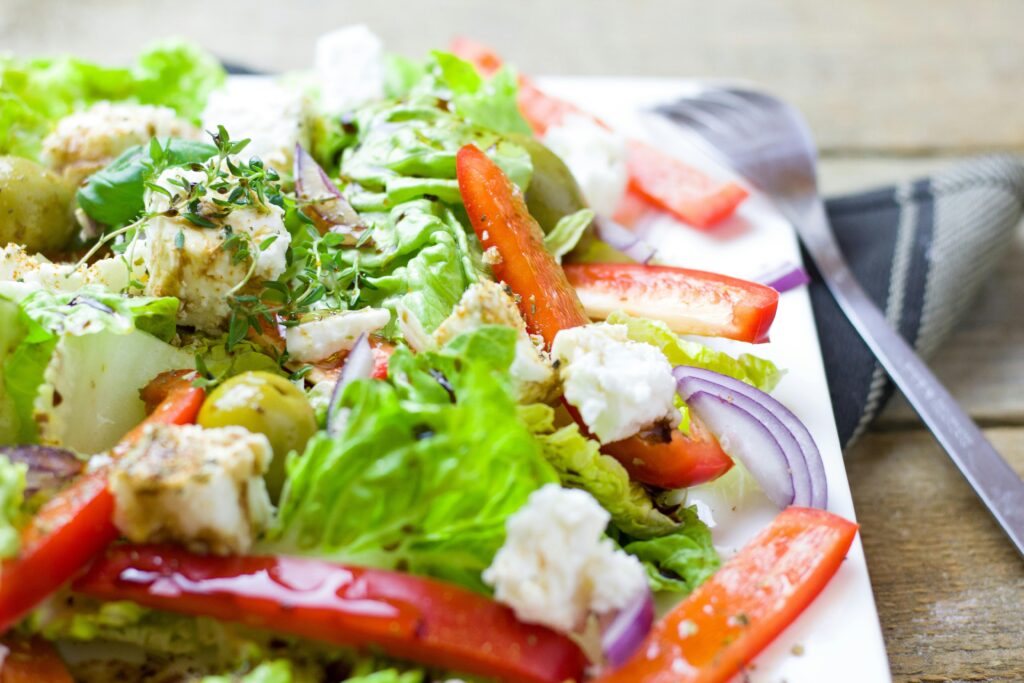Building a Green Mediterranean Salad at home is one of the simplest and most rewarding ways to bring fresh, wholesome ingredients to your table. With its crisp greens, vibrant vegetables, and bright flavors from herbs and olives, this salad delivers on both nutrition and taste. In this guide, we’ll explore how to choose the right greens, which herbs and veggies to include, how to assemble your salad beautifully, and fun ways to enjoy it. Whether you’re prepping for lunch, dinner, or a gathering, this is one dish that never gets old.
Why Green Mediterranean Salads Are So Popular
Mediterranean cuisine is often praised for its health benefits and flavor-packed dishes. But what sets a Green Mediterranean Salad apart? It’s all about the greens. Unlike the classic Greek salad, which focuses heavily on tomatoes, cucumbers, onions, and feta, this version emphasizes a fresh medley of leafy greens as its base.
That makes the dish not only more colorful and refreshing but also richer in fiber, vitamins, and minerals. The greens soak up the flavors of herbs and olive oil, giving you a more dynamic, nutrient-rich salad. Think of it as an upgrade to your everyday bowl of greens—with a Mediterranean twist.
Building a Flavorful Base: Choosing the Right Greens
The heart of this salad lies in the mix of greens. The right combination gives your salad both crunch and complexity. Here are some favorite options:
- Romaine Lettuce: Crisp and watery, it adds a cooling effect to the mix.
- Arugula: Slightly peppery, it gives the salad a bit of bite and personality.
- Spinach: Soft and tender, it blends well with stronger flavors and adds nutrients.
- Mixed Spring Greens: These bring a variety of colors, textures, and tastes to the bowl.
Don’t be afraid to experiment with proportions. For example, if your kids prefer milder greens, go heavier on romaine or spinach and lighter on arugula. A well-balanced blend makes every bite interesting.
Fresh Herbs: The Secret Flavor Booster
What makes Mediterranean food so aromatic and lively? Fresh herbs. They’re more than just garnish—they bring depth and freshness to your dish.
Here are some herbs you should try:
- Parsley: Bright and slightly peppery.
- Mint: Adds a cooling, refreshing note.
- Basil: Sweet and fragrant—perfect with tomatoes and feta.
- Dill: Earthy with a subtle tang that pairs beautifully with cucumbers.
These fresh herbs for salad should be chopped finely and evenly mixed into your greens. Not only do they enhance flavor, but they also boost antioxidants and nutrients, adding another layer of health to your meal.
Must-Have Veggies for Authentic Mediterranean Flavor
Once your greens and herbs are set, it’s time for the stars of the show—the vegetables and add-ins. Each plays a role in building the salad’s Mediterranean character:
- Cucumbers: Crunchy, cool, and full of water content. Slice them thin or cube them.
- Tomatoes: Use cherry, grape, or heirloom tomatoes for a pop of sweetness and juiciness.
- Red Onions: Sharp and vibrant; slice them thin to avoid overpowering the dish.
- Bell Peppers: Use red, yellow, or orange for color and sweetness.
- Kalamata Olives: Their briny flavor defines Mediterranean salads. Slice or pit them depending on your preference.
- Feta Cheese: Creamy and tangy, feta adds richness. Crumble it generously over the top.
These are the go-to ingredients to make Mediterranean salad feel authentic and flavorful. Each one contributes texture, color, and a unique taste that makes this dish so memorable.
Dressing Your Salad: Keep It Simple, Keep It Delicious
One of the beauties of Mediterranean cooking is how simple it is—especially when it comes to dressing. Forget the heavy bottled dressings; a drizzle of extra virgin olive oil and a splash of lemon juice is all you need.
Here’s a basic olive oil salad dressing you can make in minutes:
- 3 tablespoons extra virgin olive oil
- 1 tablespoon fresh lemon juice or red wine vinegar
- A pinch of sea salt
- A dash of black pepper
- Optional: A sprinkle of dried oregano or a tiny bit of Dijon mustard for tang
Mix well and drizzle just before serving. This light dressing highlights the natural flavors without overpowering the salad.
How to Assemble and Layer Like a Pro
Now that you’ve prepped all your ingredients, assembling your salad in the right order can make a big difference in taste and texture. Here’s a step-by-step approach:
- Start with the Greens: Spread your leafy base across a large bowl or platter.
- Add Fresh Herbs: Scatter them evenly over the greens so every bite has a burst of flavor.
- Layer the Vegetables: Add cucumbers, tomatoes, onions, and peppers—spread them out for color and variety.
- Top with Olives and Feta: These are your flavor bombs—add them last so they don’t get buried.
- Drizzle the Dressing: Add dressing just before serving to keep the greens fresh and crisp.
Using a wide salad bowl or shallow serving tray helps you get a better mix of ingredients in every forkful.
Serving Suggestions: When to Enjoy Your Green Mediterranean Salad
This salad is incredibly versatile. You can serve it as a side, a light main course, or even as part of a buffet spread. Here are some ideas:
- Main Course: Add grilled chicken, steak, shrimp, or chickpeas for a heartier meal.
- Side Dish: It pairs wonderfully with grilled lamb, fish, or flatbread.
- Lunch Option: Pack it in a container with dressing on the side for a satisfying work or school lunch.
- Entertaining: Prepare a big bowl for potlucks, picnics, or BBQs—it’s always a crowd favorite.
You can even turn it into a Mediterranean chopped salad by dicing all ingredients more finely. This version is perfect for wraps, pita pockets, or topping grain bowls.
Making It Your Own: Ingredient Variations
The beauty of this salad is that you can mix and match based on what’s in your fridge. Some variations you might enjoy:
- Avocado: Adds creaminess and healthy fats.
- Artichoke Hearts: Briny and meaty, they add texture and Mediterranean flair.
- Sun-Dried Tomatoes: For a punch of umami.
- Capers or Anchovies: For saltiness and depth (best for adventurous eaters).
- Grains: Add cooked quinoa, bulgur, or couscous for a more filling salad.
Feel free to personalize your salad with seasonal produce or your family’s favorite toppings. It’s a great way to avoid food waste and try new combinations.
Tips for Keeping Your Salad Fresh
Want to prep your salad in advance? Here are a few tips to keep it fresh:
- Store dressing separately until you’re ready to serve.
- Keep chopped ingredients in airtight containers in the fridge, layering with paper towels to absorb moisture.
- Add feta, olives, and herbs at the last minute to keep flavors bright and textures fresh.
This makes meal prep easy without sacrificing taste or crunch.
Final Thoughts
A Green Mediterranean Salad isn’t just healthy—it’s a flavorful celebration of simple, wholesome ingredients. With a vibrant mix of greens, crisp vegetables, fresh herbs, and a touch of feta and olives, it’s a dish that can be enjoyed in countless ways.
Whether you’re looking for a light lunch, a crowd-pleasing side, or a refreshing dinner, this salad brings something special to the table. It’s quick to make, endlessly customizable, and guaranteed to impress guests or satisfy your own craving for something fresh and delicious.Looking to experience authentic Mediterranean flavors without the prep? Visit Galilee Mediterranean Grill for a taste of traditional dishes made with love.

